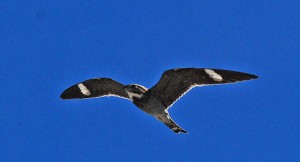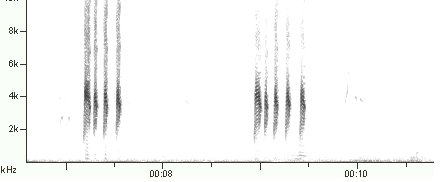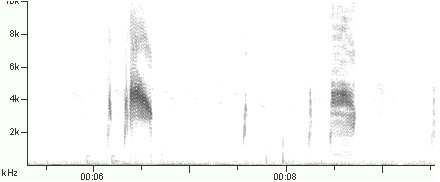A Hybrid Nighthawk?
While going through the Macaulay Library’s collection of Common Nighthawk vocalizations, I came upon something strange: a recording of what might be a hybrid Common x Antillean Nighthawk from south Florida.
Here’s some background. In the early sixties, Charles A. Sutherland studied the breeding biology of nighthawks on Key Largo, Florida. He made observations and audio recordings of both taxa breeding there: Chordeiles minor chapmani and the very different-sounding C. m. vicinus, which was not yet recognized as belonging to a separate species (and wouldn’t be until the early eighties, when the AOU would cite vocal differences and sympatric breeding in creating Chordeiles gundlachii, the Antillean Nighthawk).

Sutherland wrote up his findings in a 1963 article in Living Bird that remains perhaps the best source published to date on Common Nighthawk vocalizations. Unfortunately, he excluded the Antillean birds from his discussion. On the other hand, he did donate his recordings to Cornell, and now they can be heard online at the Macaulay Library’s website.
Sutherland’s recordings are noteworthy on many levels. For one thing, since he was in the area of sympatry, they often capture the calls of both nighthawk species at once. For another, Sutherland managed to record many rarely-heard vocalizations, such as begging calls of nestling Common Nighthawks, distraction displays by a female Antillean, and the “pik pik pik” notes given by Commons in aerial chases.
In the vocal notes on his recordings, Sutherland often referred to the Antillean Nighthawks as the “pi-ti-mi-dick” birds, after the distinctive rhythm of their calls. There is one individual, however, that he refers to as “the improper pit-i-mi-dick bird,” apparently because the thought its call didn’t sound quite right for an Antillean Nighthawk. You can hear this bird on Macaulay Library cut 5904. It used to be classified as a Common Nighthawk, but as of this writing Macaulay’s got it labeled as an Antillean, and it’s certainly a confusing bird. Here are a couple of spectrograms:
To listen to the bird, click here.
Note that the bird gives a mix of short “pik” notes (the vertical lines on the spectrogram) and Common Nighthawk-like “peent” notes (the thicker blotches). By themselves, both of these elements suggest Common Nighthawk, as that species gives both calls. However, what seems odd is that the “piks” and the “peents” usually seem to merge into one, “pik pik pikpeent,” so that the typical rhythm ends up echoing that of the stereotypical chicken vocalization: “buk buk bukKAW.” By going through every recording labeled “Common Nighthawk,” I located nine cuts that included the “pik” call [1 2 3 4 5 6 7 8 9], usually alongside the “peent,” but none of them contain anything like this combination rhythm.
Here’s a typical Antillean Nighthawk call for comparison. It’s giving a relatively stereotyped “pit-i-mi-dick” of 2-6 notes in slightly decelerating series, the first element slightly longer than the others:

(click here to hear the bird)
As far as I know, Antillean Nighthawks do not give long series of individual “pik” notes like Common Nighthawks do, but I’d be interested to hear from anyone whose experience suggests otherwise.
As you can see, the “improper pit-i-mi-dick” bird is quite different from an Antillean. It may simply be a Common Nighthawk who is stumbling repeatedly over his words. But it sounds suspiciously odd to me, and given that it comes from the area of sympatry, a hybrid seems quite plausible. Interestingly, Sutherland mentions in his vocal notes that the call of this individual is not accompanied by the rapid flutter of wings that usually accompanies the primary call in both Common and Antillean Nighthawks. Who knows what significance that fact may have?
Comments?


